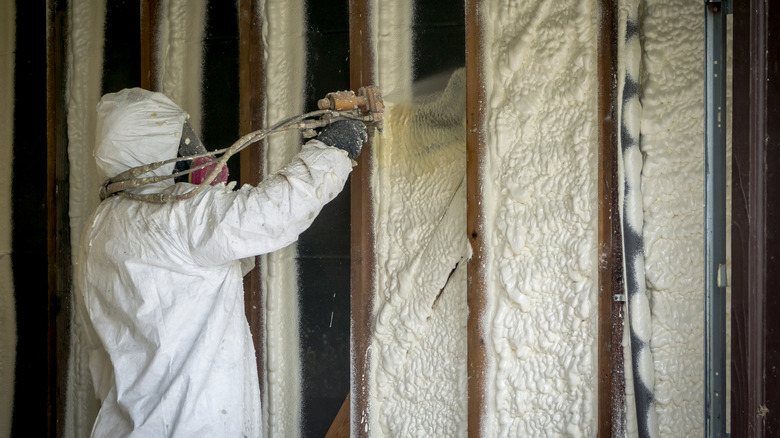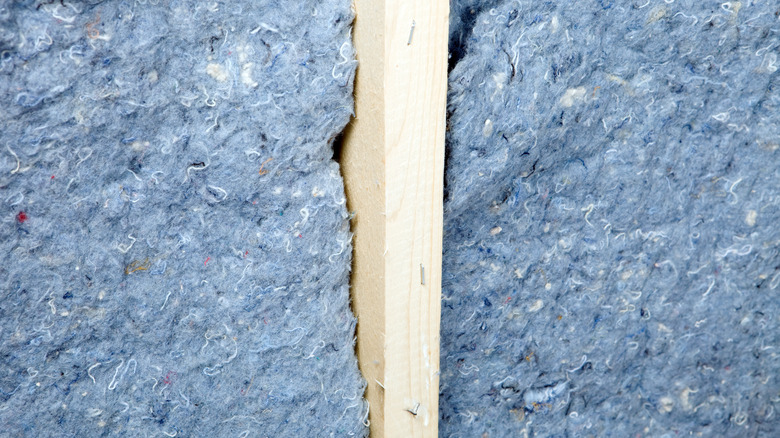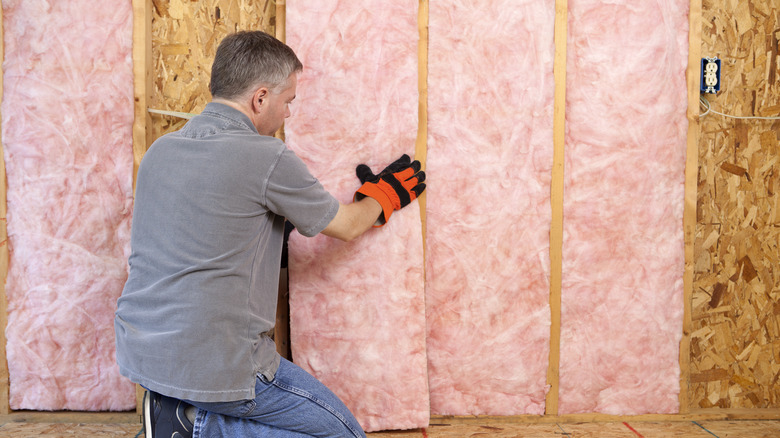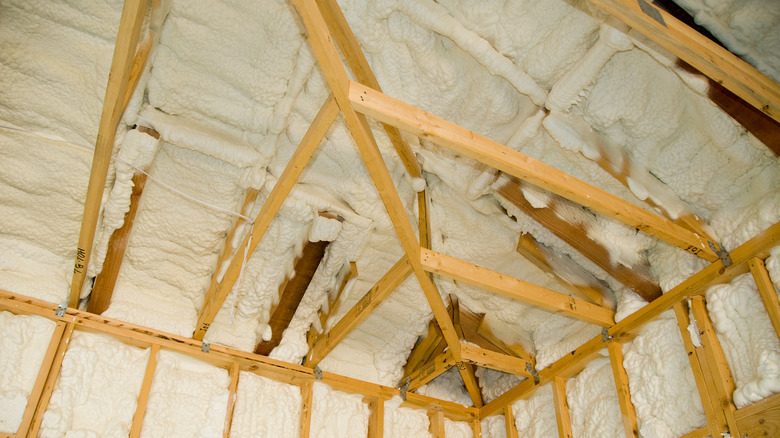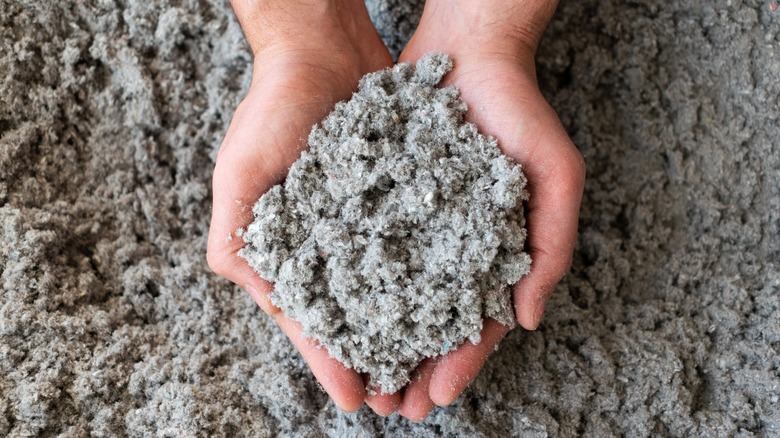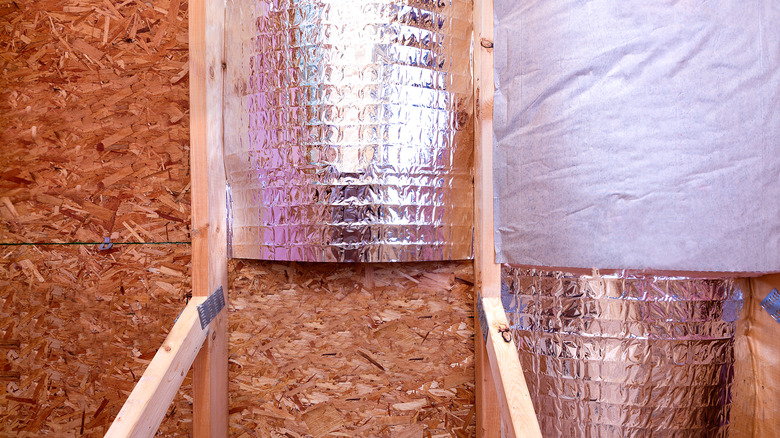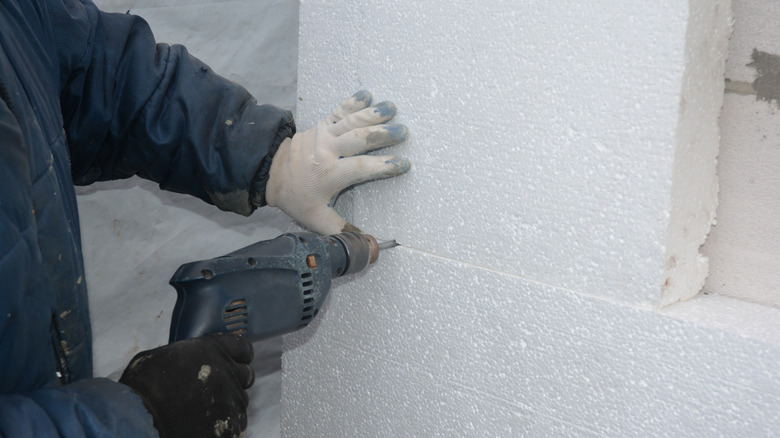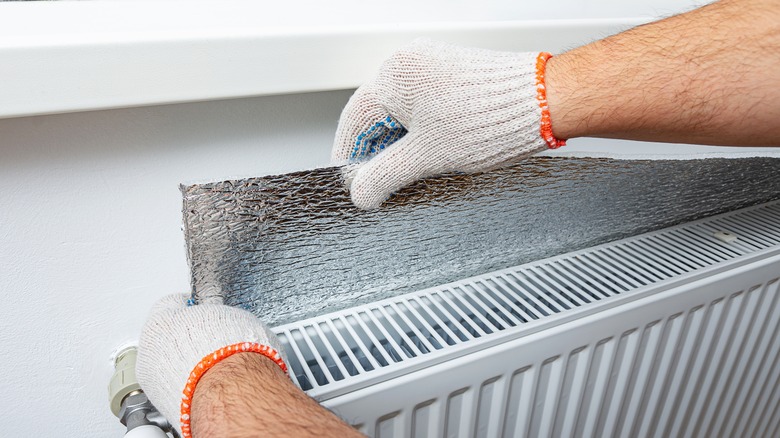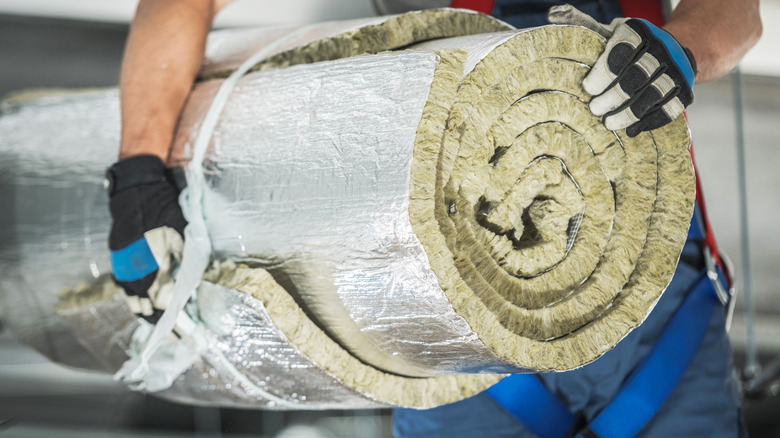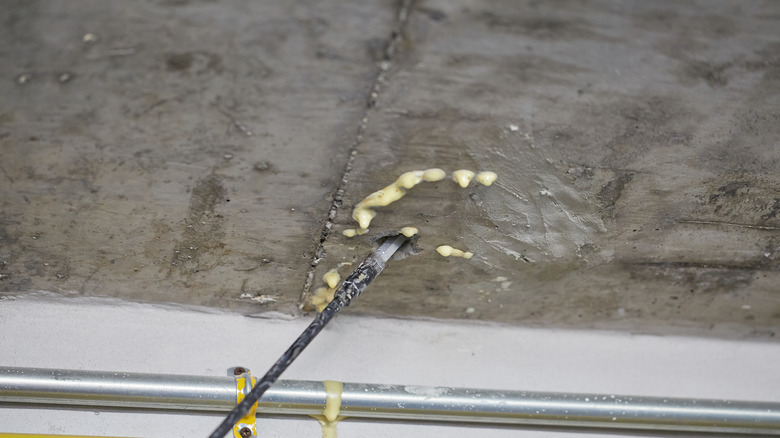How To Choose The Right Type Of Insulation For Your Garage
The garage space is a versatile area that can double as a workshop, home gym, or a place for your DIY projects. Even if you want to help your garage live up to its full potential, that part of the house usually leaks out heat and cool air, rendering it unusable for other purposes for many months each year. Insulating a climate-controlled garage is a cost-effective way to lower your energy bill, minimize outside noise, and prevent dust from coming inside your house. For this to work, you'll need to insulate every part of the garage. This includes walls, door, floor, and ceiling as well as repairing the windows, sealing gaps, and fixing water leaks.
Garage insulation comes in four categories: batt, blown-in, reflective, and foam. Not all of these are made equal. Batts work well on walls and the ceiling but not on the door. Meanwhile, reflective insulators are efficient at keeping the heat out but do a poor job of protecting the space against cold weather. When choosing the right type of insulation for your garage, you need to consider the material's level of resistance to conducting heat, aka its R-value. The higher the insulator's R-value per inch, the less heat is likely to seep into or out of the property. The following garage insulation types are classified by material, serve different purposes, and fit specific parts of the structure for maximum protection.
Denim insulation is an eco-friendly option
As the name implies, denim insulation is made from recycled jean fabrics that have been processed and treated with chemicals. A reusable material with between 85% and 100% recycled textiles, it's an eco-friendly and sustainable insulation option for the garage. The batt insulator also stands out for its fire-retardant, anti-fungal, and acoustics qualities. Treated with borate during processing, denim has a Class A fire-resistance rating, and neither mildew nor mold will grow on its surface. And since it's compressed into 2-inch thick rolls, this insulation reduces noise by up to 30%. The rolls can be installed with minimum safety precautions since they don't shed fibers or chemicals when handled.
Denim insulation has a rather low R-value of R-3.5 per inch. It can be installed on the garage's walls, ceiling, and floor. However, moisture is the enemy of this insulator, and when it gets wet, its insulation qualities degrade. This is why it's recommended to install a vapor barrier over denim for protection. Furthermore, the material isn't widely available on the market. and the large rolls are not easy to cut down to size. And unlike other more malleable materials like foam or fiberglass, the compact recycled fabric doesn't stretch to fit into space.
Fiberglass is a versatile choice
A popular insulation choice for the garage, fiberglass is a light material that can be installed on the garage door, walls, and ceiling. It comes in different forms, including batts, loose-fill, and rigid boards. Fiberglass batts and boards are made of packed glass fibers, while the loose-fill product is mainly molten glass that has been twisted into tiny fibers. The insulator has an R-value between R-2.5 and R-3.8 per inch, depending on the form of the product. Fiberglass is quite flexible and provides good insulation, although loose-fill products are more efficient insulators than either the batts or boards. It does an excellent job as a fire retardant and noise-canceling insulator.
Whatever ideas for using your garage as a room you can come up with, fiberglass insulation is quite an asset. But for all its advantages, fiberglass can also be a health hazard. Either during installation or when the insulation is disturbed, glass fibers of different sizes are released into the air. They cause damage to the skin, eyes, and upper respiratory system. When inhaled, tiny fibers can get trapped in the lungs. The insulator is also vulnerable to moisture and doesn't repel mold or mildew. As a brittle material, it offers little protection against air leaks, and when exposed to sunlight, it turns yellow over time.
Spray foam fits into tight spaces
If you're looking for an insulator that goes into every nook and cranny in the garage, no matter how tight the space, you can't go wrong with spray foam. Made of two compounds, polyol resin and isocyanate, the chemical reaction happens at the tip of the spray nozzle and creates a foam. The mushrooming foam not only insulates the walls and ceiling but also seals cracks and seams, and fills gaps in the garage. Spray foam has two subtypes: open cell and closed cell.
Open-cell spray foam has a low density and is quite flexible and soft even after it dries. The air pockets inside the foam aren't fully closed, hence the name. Its R-value averages R-4.3 per inch. With its relatively large air pockets, open-cell spray foam provides decent insulation against heat and noise. However, since the air bubbles are not sealed, both air streams and moisture can penetrate the foam, rendering it less effective in damp and windy conditions.
Closed-cell spray foam is a better insulator with its fully closed air pockets inside denser and more solid foam. It comes in two densities: medium and high, with R-values between R-5.6 and R-6.8 per inch. This compact spray foam offers more efficient insulation against mold, drafts, water, heat, and noise than its open-cell counterpart. That said, people with sensitivity to chemicals might be at risk with this insulation.
Blown-in cellulose insulation is another green option
Cellulose is a loose-fill insulation that recycles newspapers and cardboard into a safe and environmentally friendly material. With 80% old newspapers and 20% borate and other chemicals, cellulose is a fire-retardant, mold-repellent, bug-resistant, and soundproofing insulator. It works well on the garage walls and ceiling, creating a solid air barrier. Depending on the application density, its R-value averages between R-3.0 and R-3.7 per inch. The material is easy to install without the need to remove existing walls. Cellulose is blown through a hole in the wall using a blower to create an airtight and densely packed layer of insulation.
On the downside, water has a great impact on the material. Wet cellulose shrinks, leading to cavities in the insulation which reduce its heat-resistant qualities. There's also another risk of moisture interacting with the chemicals in the cellulose. If it comes in contact with metal components or electrical cables in the garage, the damp insulation could become corrosive. Additionally, both the fibers and chemicals in the insulation are considered irritants, especially in an enclosed space like a garage.
Radiant barrier is better suited for warm climates
Whether you have a detached garage, or one where the door or a wall is exposed to the sun, a radiant barrier is the go-to insulation in that situation. A radiant barrier is a durable insulator made of aluminum foil laminates or aluminized plastic films. Although it has zero R-value, the insulation can reflect up to 97% of the heat. When installed on the inside of the walls and door of the garage, they block outside heat and keep the place cool. Unlike cellulose or denim, radiant barriers are not affected by moisture and have no toxic chemicals. They can be used alone or in combination with other insulators.
But radiant barriers are not the answer to every garage insulation problem. Their applications are mostly limited to hot climates. Another downside is the potential for moisture condensation in the winter. When combined with an insulator susceptible to humidity, moisture buildup on the inside of the reflective surface could damage the insulation system. And since the radiant barrier reflects heat, it can increase the temperature of adjacent surfaces between 2 and 10 degrees F.
Rigid foam has a range of R-values
Rigid foam, or foam board insulation, is another popular option for the garage. The sheets' thickness varies between 1/2 inch to 4 inches thick, which gives the insulator different R-values. It can be applied to the garage walls, floor, and ceiling. Rigid foam comes in four subtypes. Expanded polystyrene, or beadboard, has R-values between R-3.6 and R-4.2 and is good for walls. But it has poor resistance to moisture. Extruded polystyrene, or blue board, is more water-resistant and durable than beadboard with a high R-value of R-5. However, like beadboard, it's a fire hazard.
Polyisocyanurate is the third type of foam board. It's made of a closed-cell sheet of foam enveloped in aluminum foils, giving it a high insulation R-value of R-7.7. It contains recycled materials and is both a fire-retardant and moisture-resistant insulator. Yet, the material's heat resistance degrades in cold climates. In temperatures below 50 degrees F, its R-value might drop to R-5.6. Finally, phenolic boards have the highest R-value of any insulation type, scoring an impressive R-8. The hard foam sheets are sandwiched between foil facings, giving them high resistance to moisture and mold. They can be used on garage walls and floors. However, the aluminum facings tend to trap moisture, which can lead to rust and corrosion.
Reflective insulation poses less risk of irritation
Reflective insulation works the same way as radiant barriers, but with considerable differences in the materials and how it's made. In terms of composition, a reflective insulator can be a single sheet of plastic or kraft paper with aluminum foil glued to one side. Yet a thicker variety could contain a layer of polyethylene within two bubble packs, all squeezed in between two reflective layers. In general, the thicker the material, the more effective the insulator, since it traps more air between its layers. Moreover, products with air bubble packs have an R-value between R-4.9 and R-5. Reflective insulation blocks 95% of the heat and can be fitted on the garage walls, floor, and ceiling.
While they're safe to be around since they don't shed fibers or irritate the skin or eyes, reflective insulators have their downsides. They're quite effective in warm weather but have little insulation capabilities in cold climates. This is why it's recommended to combine them with other insulation systems in colder regions. And since the material has a reflective surface, dust and dirt buildup can degrade its heat-blocking capabilities. There's also an electric shock hazard associated with the aluminum foil coating the insulator.
Mineral wool has superior soundproofing qualities
One of the best hacks for your garage is to insulate it. Mineral wool is a decent insulator made of volcanic rock or silica twisted into fine fibers under high temperatures. It has two types: loose-fill that can be blown into open walls and cavities, and batts that insulate walls, ceilings, and floors. Whatever mineral wool type is used, the open-cell structure of the fibers traps plenty of air within the layers. This reduces heat conductivity and prevents heat leaks in and out of the garage. The water-repellent and fire-resistant insulator also has excellent soundproofing qualities. Sound waves often disperse quickly as they pass through the loose fibers, which limits noise movement through the walls.
On the other hand, the insulator has a low-to-medium R-value at best. The loose-fill mineral wool's score is R-2.8, while batts are rated at R-3.7. Protective gear and safety precautions are a must when handling the material because of the loose fibers and pollutants it sheds. The insulator comes in a few size options compared to more popular insulation types. Additionally, the hefty rolls are not easy to install or cut down, especially when fitted on ceilings.
Injection foam has several benefits
When the garage has an existing drywall with cracks and gaps in it, injection foam is the right insulation and air seal choice. Made from a foam and resin mixture, it gets injected into holes in the drywall, and the insulator fills up the entire cavity. And since it doesn't expand as it hardens, it won't affect the integrity of the structure. This in turn cuts down on pollutants and dust inside the garage and reduces heat leaks. Injection foam can be applied to the ceiling, walls, and floors. And with its compact fire-retardant texture, it does a good job dampening outside noise.
Despite these outstanding features, the R-value of the insulator is around R-4.6, which is lower than that of spray foam insulation. Errors in mixing the material could lead to insulation problems such as the foam shrinking and poor sealing capabilities. There's also an issue with possible moisture buildup which can promote mold and mildew.
